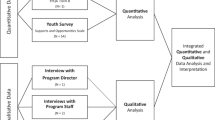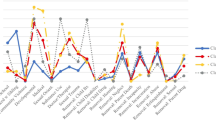Abstract
Most adolescents navigate the transition from adolescence to young adulthood with relative success. However, runaway and homeless youth experience formidable obstacles in their paths and engage in dangerous behaviors that threaten their well being and long-term prospects. This study is part of a larger exploratory research effort aimed at understanding how runaway and homeless adolescents navigate the troubled waters of their adolescence to make successful developmental transitions into young adulthood. The focus of this paper is to report findings related to the formal and informal helping resources that enable runaway and homeless youth to resolve difficulties, deal with hazards, and achieve some level of self-defined success in young adulthood. This study utilized a qualitative research design, and the primary data collection method was in-depth interviews with 12 formerly runaway and homeless young people. The constant comparative method was used to analyze the data. Evidence emerged regarding who provided help, the types of help provided, conditions that facilitated acceptance of help, and advice to helping professionals. The findings illustrate the experiences youth had with helpers that they found valuable and experiences they perceived as detrimental.
Similar content being viewed by others
References
Barth, R. P., & Schinke, S. P. (1984). Enhancing the social supports of teenage mothers. Social Casework, 65(9), 523-531.
Bielieki, J. M. (1972). Comprehensive social work in the secondary school. In R. Sarri & F. F. Maple (Eds.), The school in the community. Washington, DC: NASW, Inc.
Christopher, G. M., Kurtz, P. D., & Howing, P. (1989). Status of mental health services for youth in school and community. Children and Youth Services Review, 11(2), 159-165.
Council on Scientific Affairs, (1990). Health status of detained and incarcerated youth. Journal of the American Medical Association, 263, 987-991.
Garmezy, N. (1983). Stressors in childhood. In N. Garmezy & M. Rutter (Eds.), Stress, coping, and development in children (pp. 43-84). New York: McGraw-Hill.
Gilgun, J. (1992). Definitions, methodologies, and methods in qualitative family research. In J. Gilgun, K. Daly, & G. Handel (Eds.), Qualitative methods in family research. Newbury Park, CA: Sage.
Glaser, B., & Strauss, A.L. (1967). The discovery of grounded theory: Strategies for qualitative research. Chicago: Aldine.
Kipke, M. D., Montgomery, S., Simon, T., Unger, J., & Johnson, C. (1997). Homes less youth: Drug use patterns and HIV risk profiles according to peer affiliation. AIDS and behavior, 1(4), 247-259.
Krefting, L. (1991). Rigor in qualitative research: The assessment of trustworthiness. American Journal of Occupational Therapy, 45(3), 531-541.
Kurtz, P.D., Jarvis, S. V., & Kurtz, G. (1991). The problems of homeless youth: Empirical findings and human service issues. Social Work, 36, 309-314.
Lincoln, Y. S., & Guba, E. G. (1985). Naturalistic inquiry. Beverly Hills: Sage.
Lofquist, W. A. (1993). The technology of prevention workbook. Tucson, AZ: Associated for Youth Development, Inc.
Miles, M. B., & Huberman, A. M. (1994). Qualitative data analysis. (2nd ed). Thousand Oaks, CA: Sage.
O'Brien, C. R., Johnson, J. L., & Schmink, P. D. (1978). Death education: What students want and need. Adolescence, 13(52), 729-734.
Qualitative Solutions & Research. (1997). QSR NUDIST: Software for qualitative data analysis. Thousand Oaks, CA: Sage.
Rice, K., Herman, M., & Petersen, A. (1993). Coping with challenge in adolescence: A conceptual model and psycho-educational intervention, 16, 235-251.
Ross, C. (1980). Mobilizing schools for suicide prevention. Suicide and life threatening behavior, 10(4), 239-243.
Stanton-Salazar, R. (1995). Network orientation, social support, and coping: The question of access among low-income high school Mexican-origin youth. Unpublished manuscript. University of California San Diego, Department of Sociology, San Diego, CA.
Strauss, A., & Corbin, J. (1990). Basics of qualitative research: Grounded theory procedures and techniques. Newbury Park, CA: Sage.
U. S. Department of Housing and Urban Development. (1994). Priority: Home! The federal plan to break the cycle of homelessness. Washington, DC.
Veroff, H. W., Kulka, R. A., & Douvan, E. (1981). Mental health in America-Patterns of help-seeking from 1957 to 1976. New York: Basic Books.
Warner, E. E., & Smith, R. S. (1982). Vulnerable but invincible: A study of resilient children. New York: McGraw-Hill.
Whitbeck, L. B., & Simons, R. L. (1990). Life on the streets: The victimization of runaway and homeless adolescents. Youth & Society, 22(1), 108-125.
Zide, M., & Cherry, A. (1992). A typology of runaway youths: An empirically based definition. Child and Adolescent Social Work Journal, 9, 155-168.
Rights and permissions
About this article
Cite this article
Kurtz, P.D., Lindsey, E.W., Jarvis, S. et al. How Runaway and Homeless Youth Navigate Troubled Waters: The Role of Formal and Informal Helpers. Child and Adolescent Social Work Journal 17, 381–402 (2000). https://doi.org/10.1023/A:1007507131236
Issue Date:
DOI: https://doi.org/10.1023/A:1007507131236




